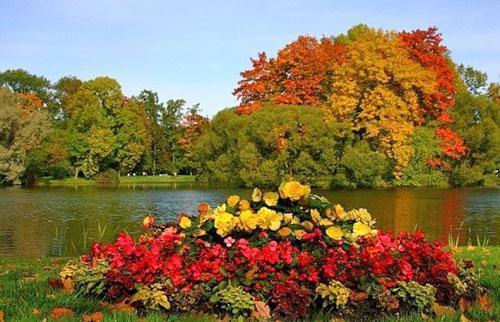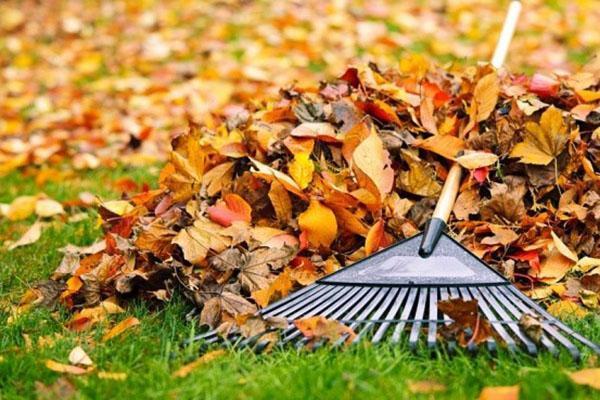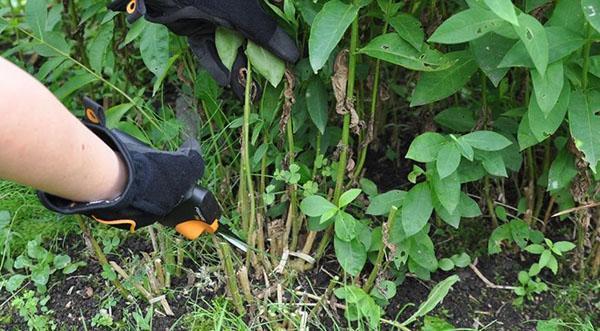Flower bed care in October
 In October, nature begins to prepare for winter. The task of any grower is to help plants maintain their strength for the coming season. To do this, it is necessary to think over the whole complex of measures in advance.
In October, nature begins to prepare for winter. The task of any grower is to help plants maintain their strength for the coming season. To do this, it is necessary to think over the whole complex of measures in advance.
General recommendations

The flowerbed must be weeded out and thoroughly loosened. This is the only way to curb the rapid growth of weeds in the spring. Remove all annuals and rhizomes. They take away strength from the soil, which deprives perennials of nutrients.
If the fall is too dry, then the earth will have to be shed with water on its own. Plants that did not receive enough moisture before wintering will not tolerate frost and will die. This is especially true for young seedlings.
It is recommended to fertilize the soil at the end of October. For this use complex mineral fertilizers... Adding ash or compost will be beneficial. Organic food is especially popular with peonies.
Preparing perennials for winter
 Perennials require special care in October. The main task of the grower is to help them survive the harsh winter. Plants such as astilbe, irises, peonies, aquilegia and so on need to be covered. Before that, remove all the foliage with a secateurs. The length of the remaining above-ground part should not exceed 5 cm. clematis shoots are cut so that two knots remain on them.
Perennials require special care in October. The main task of the grower is to help them survive the harsh winter. Plants such as astilbe, irises, peonies, aquilegia and so on need to be covered. Before that, remove all the foliage with a secateurs. The length of the remaining above-ground part should not exceed 5 cm. clematis shoots are cut so that two knots remain on them.
The root system must be mulched. It is best to use sawdust and spruce branches for this. The procedure is carried out in dry weather. Otherwise, the likelihood of developing fungal diseases increases.
Clematis shelter in a special way. At the beginning, they are covered with a small wooden box. Only after that a layer of dried leaves and spruce branches is poured on top. Covering clematis should be when the air temperature drops to 5 - 7 degrees.
Bulbous care
 Autumn is the time for planting and replanting most types of bulbous plants. In this case, you must adhere to the following recommendations:
Autumn is the time for planting and replanting most types of bulbous plants. In this case, you must adhere to the following recommendations:
- At the very beginning of October, you can start planting lilies. At the same time, the procedure for dividing old bulbs is carried out.
- They are followed by tulips, daffodils, crocuses and so on. Observe the basic rule - the depth of planting the bulb in the soil should be equal to three of its diameters. Large specimens are located farther from each other. Small bulbs are planted denser.
- Hyacinths germinate faster than others, therefore, the time of their planting is postponed. Better to do this in mid-October.
- At the end of October, all plantings must be sprinkled with a layer of fresh peat.
- If you didn't manage to dig up all the gladiolus bulbs in September, then it is not too late to do this in October. It is better to start work when the temperature drops to 3 degrees. The main thing is to have time to do everything before October 15. Spread the dug out onions on a burlap and let them dry. It will take 10 to 15 days. At the same time, the room temperature must be maintained at 25 degrees. After the bulbs are removed in a cool place for another 15 days.Transfer them to a linen bag or cardboard box and store them permanently in a cellar or refrigerator.
 Planting tulips, daffodils and lilies must be covered with plastic wrap. The rest is enough to cover with spruce branches.
Planting tulips, daffodils and lilies must be covered with plastic wrap. The rest is enough to cover with spruce branches.
If you want to get a bouquet of tulips by March 8, then start distilling them in October. To do this, the bulbs are planted in boxes with soil and stored in a cool place.
Preparing rhizome plants for winter
 Rhizome perennials such as dahlias and Cannes, it is better to dig up before winter. It is better to do this in the morning. In this case, adhere to the following instructions:
Rhizome perennials such as dahlias and Cannes, it is better to dig up before winter. It is better to do this in the morning. In this case, adhere to the following instructions:
- Cut off the aboveground part of the plants so that no more than 10 cm of shoots remain.
- Dig up the rhizome carefully. Be careful not to damage it. It is strictly forbidden to pull the rhizome by the stem.
- Clean the rhizome of excess soil with a jet of water.
- Place the tubers in the potassium permanganate solution for 30 minutes. This is necessary to disinfect them.
- After the rhizomes are dry, place them in a cool place for three weeks. They should dry completely.
- Fold the prepared planting material in a wooden box, cover it with sawdust, peat, vermiculite and sand.
- Store in a basement or cellar for permanent storage.
Proper preparation of flowering plants for winter will help keep the entire flower garden intact. You don't have to buy new planting material and plan new flower beds in the spring.